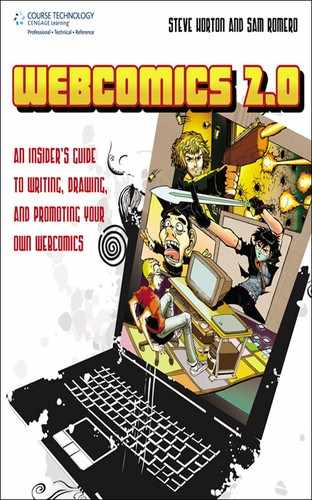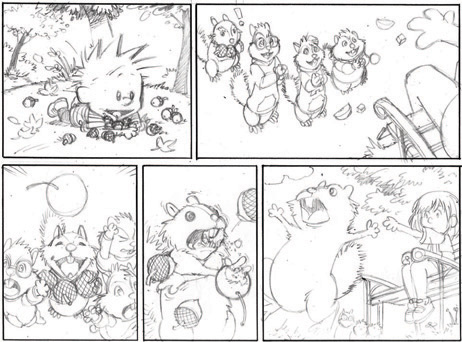Has anyone ever e-mailed you a link to a webcomic? Odds are, they sent it to you because it was funny and relevant. Many of the best and most popular webcomics on the net, like many newspaper comic strips, are purely humor based or contain strong humor elements. Unlike newspaper strips, though, humor webcomics are not confined to three or four postage stamp–size panels. Humor webcomics are also not subject to the sensibilities of newspaper demographics, which can skew much older than the average webcomics fan, and are not subject to severe restrictions on content imposed by newspapers and print syndicates. Many creators use the canvas of the Web to create comics of all shapes and sizes—sometimes varying that size from day to day!
Humor comes in infinite forms in webcomics, but as far as popularity goes, subject matter has seemed to settle on several distinct forms. That’s not to say that you have to fit into one of those niches. In fact, the existence of these popular types might serve as a warning to try something different—or risk drowning in a sea of look-alikes!
Video game humor is a frequent topic of webcomics. Why is that? Simply put, gamers use the Internet frequently, and frequent Internet users are often gamers. Also, the same creativity that drives gamers to win also empowers them to write and draw.
There are dozens of video-game webcomics that lampoon the industry, use video games as a backdrop for situation comedy, and even tell funny stories from within a particular video game world.
There is tremendous depth and breadth among the video-game webcomics subgenre. Following are four examples that are about as different as webcomics can be from one another and still have something to do with video games.
The most popular video game webcomic—and one of the most popular webcomics on the entire Internet—is called Penny Arcade (http://www.penny-arcade.com). Drawn by Mike Krahulik and written by Jerry Holkins, otherwise known as Gabe and Tycho, Penny Arcade has spawned a yearly convention called the Penny Arcade Expo, a game charity drive for children’s hospitals called Child’s Play, and a series of reprint books through Dark Horse Comics.
Another popular webcomic, PvP by Scott Kurtz (www.pvponline.com), began life as video game humor before morphing into a situation comedy/general pop culture humor strip.
VG Cats, created by Scott Ramsoomair (www.vgcats.com), is a well-drawn video game strip starring anthropomorphic cats that spends its time satirizing specific video game titles.
And then there’s Steve Napierski’s Dueling Analogs (see sidebar), which is almost entirely single-gag strips with wicked satire against video games. But even this one has a recurring cast.
Bottom line is—there are a lot of them, and many are popular, but many aren’t. Diving into this world would require you to find a niche that’s not already filled. Don’t just copy an existing comic. If you can discover a unique angle in video game humor, go for it.
There are many sci-fi parody comics on the Web. Usually, these strips tend to focus on ships or crews in space discovering wacky situations, in a kind of riff on Star Trek or Star Wars. Good examples of humor in a sci-fi vein include Steve Troop’s Melonpool (www.melonpool.com), Pete Abrams’ Sluggy Freelance (www.sluggy.com), and Kristofer Straub’s Starslip Crisis (www.starslipcrisis.com).
Possibly the longest-running of these and one of the most popular is Howard Tayler’s Schlock Mercenary (see sidebar), about a team of spacefaring mercenaries.
Autobiographical or semi-autobiographical humor strips are those that take the creator’s life and make it more interesting for fiction. By dramatizing and humorizing elements that the creator sees and hears in his daily life, a realness and an unrealness merge to create a greater whole. Think of them as the visual counterpart to a personal blog.
One popular autobiographical webcomic is the appropriately named Real Life, by Greg Dean (www.reallifecomics.com).
Another good example of this type is Jennie Breeden’s The Devil’s Panties (see sidebar).
Finally, there’s pop culture humor, which is where our webcomic example fits. Just like it sounds, pop culture humor webcomics make fun of whatever’s popular.
One important pop-culture humor webcomic has made enormous gains in popularity and readership in a very short time. It’s called xkcd, and it’s created by X. Through the use of science, romance, and math-based humor, as well as iconic stick figures, X has reached an untapped audience in the hundreds of thousands.
Another pop-culture strip,Shortpacked!, by David Willis (see sidebar), lampoons toy retail, including those who work there, those who shop there, and the toys themselves. It also takes time for one-off gag comics about some element of pop culture, usually Batman, GI Joe, or Transformers.
And now we come to our webcomics example. Created by webcomics writer T Campbell and used with permission, and drawn by Webcomics 2.0 artist Sam Romero, The Versus Versestakes two pop culture characters or elements that happen to sound alike and puts them in a rhyming duel. Sounds strange? It is, but oddly, it works. The Versus Verses satirizes everything from Harry Potter and Welcome Back Kotter to Calvin & Hobbes and Alvin and the Chipmunks (see the rhyme?).
Romero started with pencil art (Figure 2.1), inked it (Figure 2.2), and finally created a final color drawing, coloring in a Sunday newspaper comic style (Figure 2.3).
The full The Versus Verses comics can be found at the center of this book. You’ll notice that Versus Verses doesn’t limit itself to a single format, often rearranging its panels in multiple directions. This is an example of “infinite canvas,” or using the medium of the Web to create webcomics of any direction and size. Here’s a look at the preliminary versions, so you can see how Romero got to the finished drawing.
Humor webcomics, in large part, serve an audience different than that served by newspaper strips. Humor webcomics fans are younger and more interested in Internet culture. These fans like online gaming, blogging, MySpace, and satire. They like their entertainment to bite back at them. Webcomics creators have responded to that need and have created humor strips that would not belong anywhere else but on the Web. You can, too.



